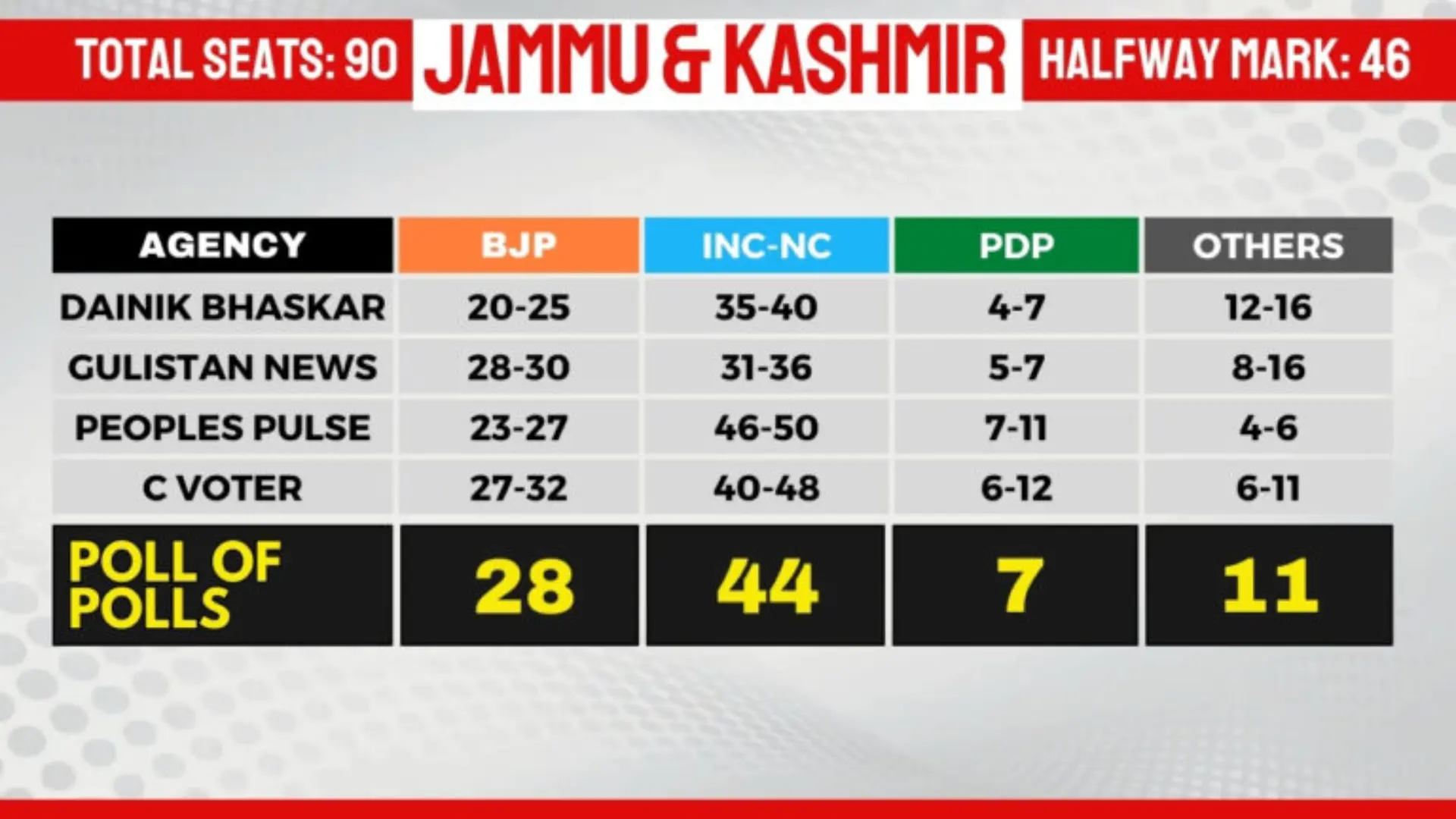Regional political players contesting in the upcoming Jammu and Kashmir elections include the Jammu & Kashmir National Conference (NC), Jammu & Kashmir People’s Democratic Party (PDP), J&K People’s Conference (PC), J&K People’s Movement (JKPM), and J&K Apni Party. On the national level, Congress has formed an alliance with NC, whereas the BJP is set to contest independently.
The previous assembly elections in Jammu & Kashmir took place in 2014. During that election, none of the major parties were able to secure a clear majority. The PDP, led by Mehbooba Mufti, won 28 seats, making it the largest party, while the BJP followed with 25 seats.
The Jammu and Kashmir assembly requires 46 seats for a simple majority. As neither PDP nor BJP reached this mark, the two parties entered into a coalition government, which lasted until June 19, 2018.
How Did Other Parties Fare In 2024 J&K Assembly Polls?
Dainik Bhaskar’s exit poll suggests that the INC-NC alliance will secure 35-40 seats, while the BJP is expected to win 20-25 seats. The PDP, which was the BJP’s ally in the previous government, is likely to get 4-7 seats, with other parties receiving 12-16 seats.
Gulistan News projects 31-36 seats for the INC-NC alliance, while the BJP is expected to win 28-30 seats. The PDP could win 5-7 seats, with other parties securing 8-16 seats.
People’s Pulse indicates that the INC-NC alliance will surpass the majority mark with 46-50 seats, while the BJP is projected to win 23-27 seats. The PDP is expected to get 7-11 seats, and other parties may secure 4-6 seats.
C Voter’s exit poll predicts that the INC-NC alliance will win 40-48 seats, while the BJP is expected to secure 27-32 seats. The PDP is projected to receive 6-12 seats, and others will likely win 6-11 seats.
According to Axis My India, the contest between the BJP and the INC-NC alliance is close. The BJP is projected to win 24-34 seats, while the INC-NC alliance is expected to secure 35-45 seats. The poll predicts the PDP will win 4-6 seats, with other smaller parties receiving 8-23 seats.
What Happened Last Time?
On June 19, 2018, the coalition fell apart as the BJP pulled out, citing differences with the PDP on key issues, including their stance on militancy. This led to the imposition of Governor’s rule in Jammu and Kashmir, which eventually culminated in the abrogation of Article 370 and the reorganization of the state into two union territories—Jammu & Kashmir and Ladakh.
Significant changes have occurred in the region since 2018. Article 370 was removed, ending Jammu and Kashmir’s special status and leading to its division into two union territories. Additionally, a delimitation exercise was conducted, which resulted in redrawn boundaries and changes to reservation policies for Scheduled Castes and Scheduled Tribes.
The INDIA bloc (comprising the Jammu Kashmir National Conference, Congress, and Communist Party of India-Marxist) has announced 66 candidates for the upcoming elections, including six for “friendly contests.” The BJP has put forward 51 candidates, mostly in the Jammu region, while the PDP has fielded over 40 candidates, focusing primarily on the Kashmir Valley.
Since the BJP withdrew its support for the PDP-led government in 2018, Jammu and Kashmir’s political dynamics have shifted significantly. The revocation of Article 370 in 2019, along with subsequent delimitation, not only changed boundaries and increased seats but also set the stage for the 2024 elections, prompting all parties to reconsider their approaches.
In the 2014 election, the PDP secured the most seats with 28, while the BJP won 25. The National Conference, which had led the government at that time, won 15 seats, and Congress took 12 seats. However, the vote share told a different story, with BJP receiving 23.2%, PDP 22.9%, NC 21%, and Congress 18.2%.
Given the lack of a clear majority, an unexpected coalition was formed between the PDP and the BJP. Omar Abdullah of NC resigned as Chief Minister, and after a period of President’s Rule, the PDP-BJP alliance established the government.
The fragmented outcome in 2014 was consistent with the election results in 2002 and 2008. During the 2008 elections, held amidst boycott calls and increased security, the NC emerged as the largest party, winning 28 seats with a 23.1% vote share. PDP followed with 21 seats and a 15.3% share, while Congress secured 17 seats (17.8% vote share) and BJP got 11 seats (12.4% vote share). The NC formed an alliance with Congress, resulting in Omar Abdullah taking office as Chief Minister.
MUST READ: NewsX Expertometer: NC-Congress Alliance to Lead With 35 Seats In Jammu and Kashmir



















